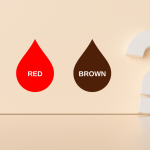
The color of your period blood can tell you more than you think. Variations from bright red to deep brown are normal. Understanding period colors’ meanings can help you track your menstrual health and recognize when something might be wrong.
While occasional changes in color are usually nothing to worry about, it’s important to be aware of certain patterns and other symptoms that could signal an underlying health issue.
If you notice significant changes in your period, such as prolonged heavy bleeding, clotting, or irregular cycles, it is important to consult with a healthcare professional. These might be signs of fibroids or other uterine conditions. Schedule a fibroid health screening today for an evaluation to help determine the cause and explore treatment options.
Period Blood Color Meanings
Period blood color changes can be a regular part of your monthly cycle or a sign of conditions such as uterine fibroids, hormonal imbalances, or infections. However, blood color alone is not a reliable indicator of these conditions. These conditions usually present with other symptoms as well, such as:
- Fibroid Symptoms: Heavy or prolonged periods, pelvic pain, bloating, frequent urination.
- Hormonal Imbalance Symptoms: Irregular periods, changes in mood or energy levels, acne.
- Infection Symptoms: Foul odor, unusual discharge color/consistency, pain while urinating.
| Period Blood Color | Normal | Potential Concerns |
| Bright Red | Signifies menstrual cramps. | Fibroids, if accompanied by heavy bleeding. |
| Dark Red or Brown | Indicates older blood. | Linked to fibroids or hormonal imbalances. |
| Pink | Mix of menstrual blood and cervical fluid. | Irregular shedding of the uterine lining. |
| Orange or Yellow | Require further evaluation. | May indicate an infection. |
What Period Blood Color is Abnormal?
While some variations in period blood color are normal, specific changes may signal health issues.
Some colors of menstrual period blood that are abnormal and that may indicate an underlying condition include:
- Persistent bright red bleeding after your period ends may signal hormonal imbalances.
- Orange, yellow, or gray discharge may indicate infection.
- Large blood clots (bigger than a quarter) are often associated with heavy bleeding, which may be a sign of a uterine condition.
- Consistently dark or brownish blood can be an indication of uterine fibroids.
Abnormal bleeding isn’t just about period blood color—it can also involve excessive blood loss, periods lasting longer than a week, or cycles becoming shorter with heavier bleeding. These abnormal changes with menstrual periods can indicate uterine fibroids. If you’ve been noticing heavy, prolonged menstrual bleeding, as well as pelvic pain and frequent urination, seek an expert opinion from a fibroid specialist.
Why Is My Period Blood So Dark?

Dark brown or black menstrual blood is a sign that older blood takes longer to leave the uterus, allowing it to oxidize and darken. This menstrual blood color can be common at the beginning or end of a period when the flow is slower.
However, it is important to pay attention to your overall menstrual cycle. While occasional dark blood is not a cause for concern, certain health conditions can be potential causes of abnormally dark period colors, including:
Seek medical advice if heavy bleeding, a strong odor, intense pain, or sudden changes in flow accompany it.
What Color Is Fibroid Bleeding?
Fibroid-related bleeding can appear in different colors and patterns, such as (heavy flow, prolonged periods, or bleeding between periods). A few typical period colors and patterns associated with fibroids include:
- Bright red blood: Often associated with a heavy flow and may indicate fibroids or other uterine conditions.
- Pink spotting between periods: This may result from hormonal imbalances or fibroids affecting the uterine lining. The pink tinge is typically due to blood spotting and cervical mucus mixing.
- Dark red blood during prolonged bleeding: This can occur due to fibroids causing extended or irregular periods.
- Brown blood: This may indicate older blood obstructed by fibroids, especially if located near the cervical opening or within the uterine cavity.
How Fibroids Affect Period Blood Color and Flow
Fibroids can disrupt menstrual patterns by altering the shedding of the uterine lining, leading to excessive bleeding, irregular cycles, and prolonged periods. These irregular patterns occur due to increased pressure on the uterine lining, disruption of blood vessels, impaired uterine muscle contractions, and hormonal fluctuations.
Fibroids’ type, size, and location within the uterus directly impact menstrual blood color and flow. Some fibroids can lead to heavy bleeding with clotting, while others may cause mid-cycle spotting or prolonged periods.
Types of Fibroids & Their Impact on Menstrual Bleeding:
- Submucosal fibroids: Grows directly beneath the uterine lining, often causing heavy bleeding, prolonged periods, and clot formation.
- Intramural fibroids: Develop in the uterine wall and can contribute to excessive bleeding and period abnormalities.
- Subserosal fibroids: Grows on the uterus’ outer surface. They typically do not affect menstrual bleeding but can cause symptoms like pelvic pain and painful intercourse.
Unusual period colors accompanied by severe cramping, prolonged periods, or bleeding between cycles can signify fibroids. If you experience these symptoms, schedule a consultation with a specialist at USA Fibroid Centers to determine the best treatment option.
MEET WITH A FIBROID SPECIALIST
Treatment Options for Fibroid-Related Period Changes

For those diagnosed with fibroids, minimally invasive treatment options, such as uterine fibroid embolization (UFE), are available. UFE shrinks fibroids, reduces heavy bleeding, and restores normal menstrual patterns, helping women regain control over their cycles without surgery. In addition to the FDA-approved treatment’s effectiveness, UFE has fewer risks than other procedures such as hysterectomy or myomectomy.
Seeking early treatment can help manage symptoms and prevent complications, ensuring better menstrual health. You can schedule a consultation online at USA Fibroid Centers or by calling 855.615.2555.
Menstrual Blood Color FAQs
What Color Should Period Blood be?
Depending on the flow and individual factors, period blood color can range from bright red to dark brown. Bright red blood typically appears at the beginning of a period and indicates fresh blood, while dark red suggests older blood that has been in the vagina longer. Brown blood may result from blood mixing with cervical mucus or other discharge, whereas pink blood can appear at the end of a period or with lighter flow.
What Does it Mean if My Period Color is Very Light?
Light-colored period blood can result from normal cycle changes, hormonal shifts, or underlying health conditions. It may occur during the early or late phase of a period when mixed with vaginal discharge, creating a pink hue. Hormonal fluctuations from birth control, perimenopause, or stress can also impact flow and color, as can lifestyle changes such as significant weight loss. Sometimes, anemia may cause menstrual blood to appear unusually pale or watery. While occasional lighter periods are normal, discuss any sudden changes in color or flow with a healthcare provider.
Can Diet or Lifestyle Affect Period Blood Color?
Diet and lifestyle can influence the color and consistency of period blood. For example, an iron deficiency may cause darker menstrual blood, while an imbalanced diet can lead to paler blood. Stress, poor sleep, and lack of exercise can disrupt hormone levels, potentially affecting period color and flow.
How Does Age Affect Period Blood Color?
Hormonal changes during perimenopause and menopause can impact the blood’s color and consistency. During perimenopause, fluctuating estrogen levels can cause the uterine lining to break down at different times, leading to variations in cycle length, blood flow, and discharge texture. Brown blood may appear more frequently as spotting or at various points in the cycle.
After reaching menopause, menstruation should stop entirely. A doctor should evaluate any postmenopausal bleeding.
Are There Specific Period Blood Colors that Indicate Fibroids?
Fibroids located near the cervical opening or within the uterus may disrupt normal blood flow, leading to dark brown or heavy bleeding. Additionally, fibroids are linked to heavy or prolonged periods, spotting or irregular bleeding between cycles, and severe menstrual cramps.
If you experience persistent period color changes alongside these symptoms, consult a fibroid specialist from USA Fibroid Centers for diagnosis and treatment.



